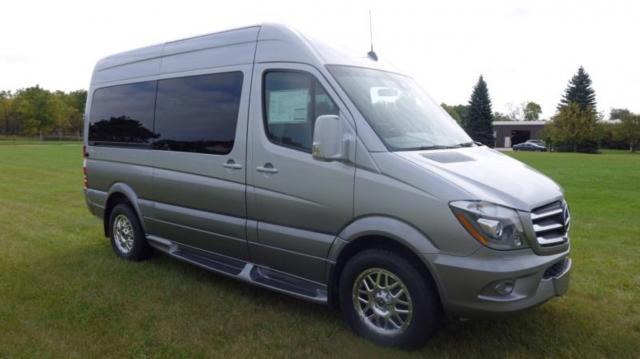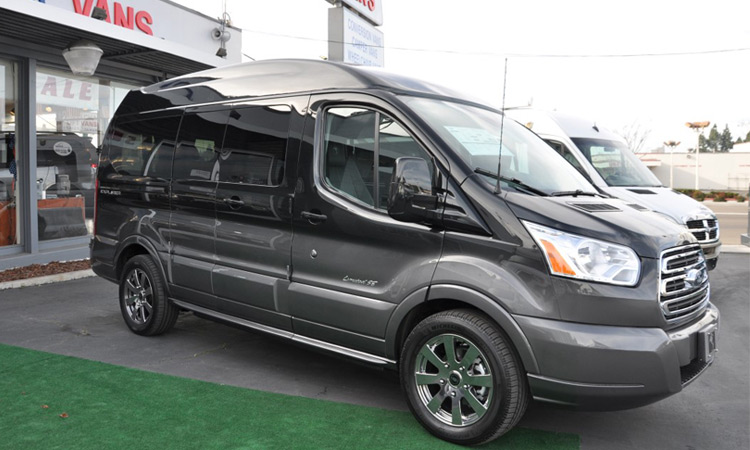
An in-depth comparison of the Mercedes Sprinter and Ford Transit vans
When comparing the 2 best-selling camper and conversion vans in North America, breaking down their differences and similarities is key to understanding why some folks prefer the Mercedes over the Ford, and vice-versa. Deciding which van is right for you essentially comes down to what you want to do with it.
Are you planning to do a lot of off-grid camping?
Do you need a vehicle to haul tools, toys and equipment?
Is comfortable and safe family transportation an important feature?
Once you’ve narrowed down your use criteria, you can piece together the standard and optional features of the Sprinter and Transit to determine which vehicle is best for your needs.
Sometimes the sum of a van comes down to more than just its specs. By that, we mean that some folks may simply feel a patriotic tug towards Ford because their parents or grandparents always drove Fords. The same could be said of Mercedes. Some may simply desire that brand because they’ve always wanted to own a Mercedes, or they believe they’re buying the best when they buy a Mercedes.
But for those of who you are somewhere in the middle of the Ford Transit vs. Mercedes Sprinter debate, this article is for you. We’ll start by laying out pros and cons of each van, as well as highlight specific features that are unique to each model.
Dimensions comparison: Transit vs. Sprinter
The standing room inside a standard Sprinter is 5 feet 5 inches high. The high roof Sprinter bumps up the interior standing space to 6 feet 4 inches. In contrast, the standard Transit just beats out the standard Sprinter with a standard standing space of 6 feet. The high roof Transit also wins out at 6 feet 8 inches. For this reason, Transits tend to be more popular among taller vanlifers.
However, when it comes to length, the Sprinter wins out. The Sprinter’s standard length is a 144-inch wheelbase, whereas the Transit has a 130-inch wheelbase. The Sprinter extended length version comes in at 170 inches, while the Transit tops out at a 148-inch extended wheelbase.
Available cargo space between the 2 vans is very similar, starting on the low side at 315 cu. ft. Maximum cargo space tops out at 487 cu. ft for the Transit and 530 cu. ft. for the Sprinter.
Engine comparison: Transit vs. Sprinter
When it comes to engine options for a brand new Transit, Ford now offers 2 powertrains. The base engine comes with a 3.5-liter V-6 that provides 275 horsepower and 262 lb-ft of torque. The turbocharged engine comes with a 3.5-liter V-6 available that generates 310 horsepower and 410 lb-ft of torque. Both engine options are available in rear-wheel or all-wheel drive (buyer’s choice), and come paired with a 10-speed automatic transmission.
Mercedes offers a standard powertrain that comes with a 2.0-liter V4 with a 9-speed automatic transmission. This standard option delivers 188 horsepower. The Sprinter also comes in 2 turbo-diesel options: a 2.1-liter (161 horsepower and 265 lb-ft of torque) and 3.0-liter V6 (188 horsepower and 325 lb-ft of torque).
Both the Transit and Sprinter have a maximum towing capacity of 7,500 pounds.
Fuel economy and range comparison: Transit vs. Sprinter
The Transit has a fuel-economy rating of 15 mpg in the city, 19 mpg on the highway and 17 mpg combined for the rear-wheel-drive model, and 14/19/16 mpg for the all-wheel-drive version. The van also has a flex-fuel engine meaning you can put E85 ethanol in the tank, but doing so will drop your fuel economy. With a 25-gallon fuel tank, that means you can go anywhere from 350 miles to 475 miles on a single tank—give or take, depending on how much you’re hauling, weather conditions and other factors.
In comparison, the Sprinter can get up to 21 mpg in the city, 24 mpg on the highway and 22 mpg combined for both low-top and high-top models. At a 22-gallon capacity, the size of the Sprinter’s fuel tank is slightly bigger than the Transit, meaning you can drive longer without having to stop for gas. With the Sprinter, you can go anywhere from 462 miles to 528 miles on a single tank—again depending on weather conditions and other factors.
General Sprinter van pros and cons
Pros
Sprinters have proven popular among DIY campervan enthusiasts for many years. For starters, they’ve been in production longer than the Transit, so there are older used examples available that may fit your budget. There’s also lots of ideas and support to be found in Internet forums should you decide to convert it to a camper, as well as plenty of aftermarket (and factory) equipment available to help you convert it into the rig of your dreams.
Four-wheel-drive is also an option on the Sprinter, and the build quality of these vans is generally considered slightly better than Ford Transits. In addition, Sprinters have multiple versions of diesel motors as options, which many prize for their fuel efficiency.
Lastly, Sprinters are known for their longevity and durability. Some Sprinters have more than 600,000 miles on them!
Cons
On top of being pricey when purchased new, maintenance and repairs on your Sprinter can be costly. Mercedes dealerships are generally your best bet for most repairs. Even routine maintenance is reported to be costly and slow, partly because certain rare parts may have to be shipped from Germany which can take days or even weeks.
Ironically, the Sprinter is also rather slow at accelerating compared to the Transit and other comparable camper vans.
General Transit van pros and cons
Pros
Transits are typically more affordable when purchased new compared to the Sprinter. In addition, parts are more readily available and cheap, plus these vans can be serviced by any competent mechanic.
As previously mentioned, the Transit also has a taller roof on some models, making it feel more spacious and roomy inside—even for tall folks. All-wheel-drive is available on some models, allowing you to hit some of those off-road destinations. Drivability is also good, with some users reporting that the Transit drives similarly to a sedan.
Cons
Transits are newer to the market, so there are fewer used ones out there, as well as a bit less support and aftermarket accessories available compared to the Sprinter.
Few Transits have the diesel motor, so if that is important to you then you might have to look at the Sprinter. In addition, most Transits get worse gas mileage than diesel Sprinters—between 3 and 5 mpg less. Plus, some users say that the Transit cab is a bit tight.
Which camper van is right for you — Transit or Sprinter?
If the Transit’s capabilities, features and abilities tick off most of your boxes, then go for it. If the Sprinter is your dream vehicle, just be aware of the added expenses and costs to operate this wonderful rig. On the flip side, the Sprinter may have a better resale value down the road compared to the Transit.
To summarize, it all depends on what you’re looking for.
If you’re wanting a reliable, affordable daily-driver that you can customize into a campervan, you should consider the Ford Transit. However, if you’re looking for a van to live in full-time and are willing to splurge for quality, luxury and durability (not to mention some 4×4 off-roading capability), the Mercedes Sprinter might be the right vehicle for you.
As with any big purchase, you should always take a new or used camper van out for a test-drive before buying. Don’t get your heart set on a specific brand or model without first seeing how each one feels out on the road. After all, behind the wheel is where you’ll spend most of your time, right?
At Classic Vans, we know a thing or 2 about camper vans and van conversion—including the Mercedes Sprinter and Ford Transit. As America’s #1 dealer of conversion vans, we’ve been selling them to happy, satisfied customers for decades. You can always find a van that’s the perfect fit for you at Classic Vans.
Ready to begin your next adventure? Browse Classic Vans’ wide selection of new and used camper vans for sale. We’re certain we can help you find the right rig that will suit your needs and fit your budget. Our knowledgeable team of sales professionals and van techs have decades of experience. We can help you find the rig of your dreams! After all, we’ve been doing it for over 30 years.
Don’t live in California? No problem! Ask about our low-cost nationwide van-delivery.

